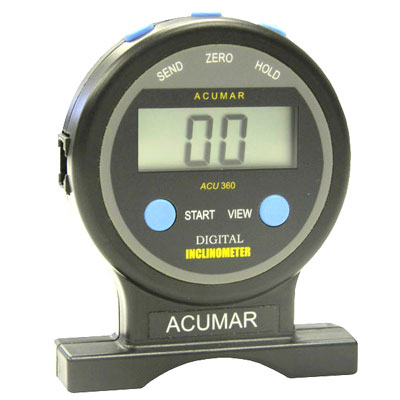Inclinometers

General back pain, postural deviations, and musculoskeletal injury to the spine or associated musculature can lead to loss of muscle strength and a loss of range of motion (ROM) in the spinal movements of flexion, extension, lateral flexion, and rotation. These movements are so vital to daily movements and accentuate the need for rehabilitation intervention to restore muscle strength and lost ROM back to a quality of life free from pain and limited mobility.
Measuring spinal ROM at the beginning or baseline of therapy and along the rehabilitation progression is essential in evaluating the effectiveness of the treatments given to the patient. Inclinometers are a more accurate and reliable method of measuring range of motion of the spine. Defined as an instrument that measures the angle of slope (or tilt) at which the inclinometer is situated relative to the line of gravity, a inclinometer is a helpful tool for measuring ROM in a specific spinal segment such as trunk flexion and extension or lateral flexion. An additional advantage is that inclinometers can be used in pairs to measure combination/composite movements. For example, instructing a patient to bend forward toward touching their toes is a combined movement of the hip joint and lumbar vertebral segments. This can help determine if each of these is allowing the appropriate or normal ROM. More specifically, diagnostic information may be observed relative to if a painful low back is the result of the lower back compensating for limited hip joint ROM.
How to Use an Inclinometer
The therapist holds the inclinometer on the patient’s back when in the upright position, and “zeroes-out” the inclinometer. Then, while continuing to hold it against the patient’s back (never move or allow the inclinometer to lose contact with the back) the patient bends forward through their available range of motion. The inclinometer’s final reading is the ROM measurement in degrees.
Cervical Range of Motion (CROM) devices are inclinometers built into a device that fits to the head and includes magnets that measure ROM of the neck or cervical spinal segment. Being fixated to the head, it eliminates slippage, positioning, zeroing, and tracking errors that can occur in stand-alone inclinometers and effectively measures rotational movements in the upright position.
Shop ProhealthcareProducts.com for a variety of inclinometers (single bubble, digital dual inclinometers) and CROM spinal assessment devices from industry leaders in musculoskeletal assessment like Baseline, Acumar, Hoggan Scientific, and JTECH.
If you need help finding an inclinometer to suit your particular needs, please contact ProHealthcareProducts.com customer service.




